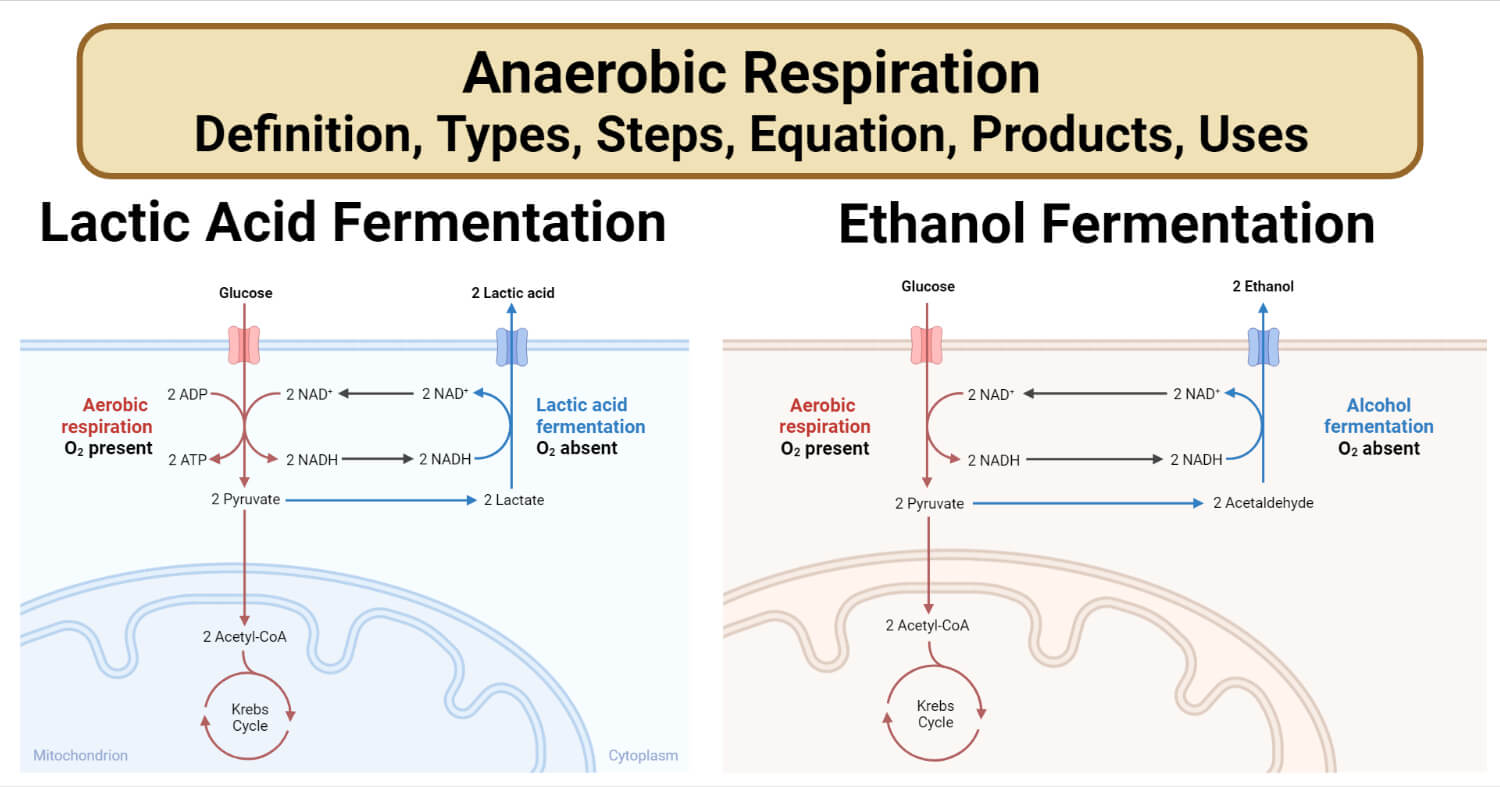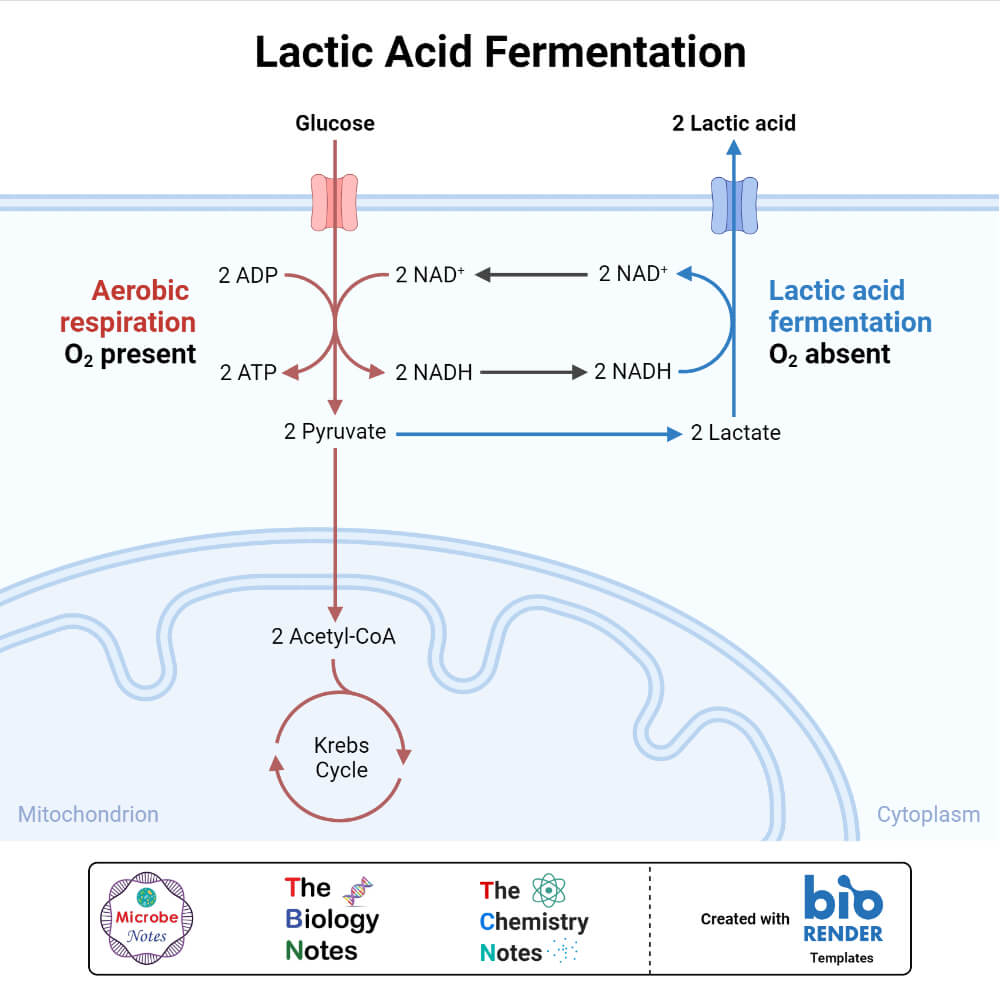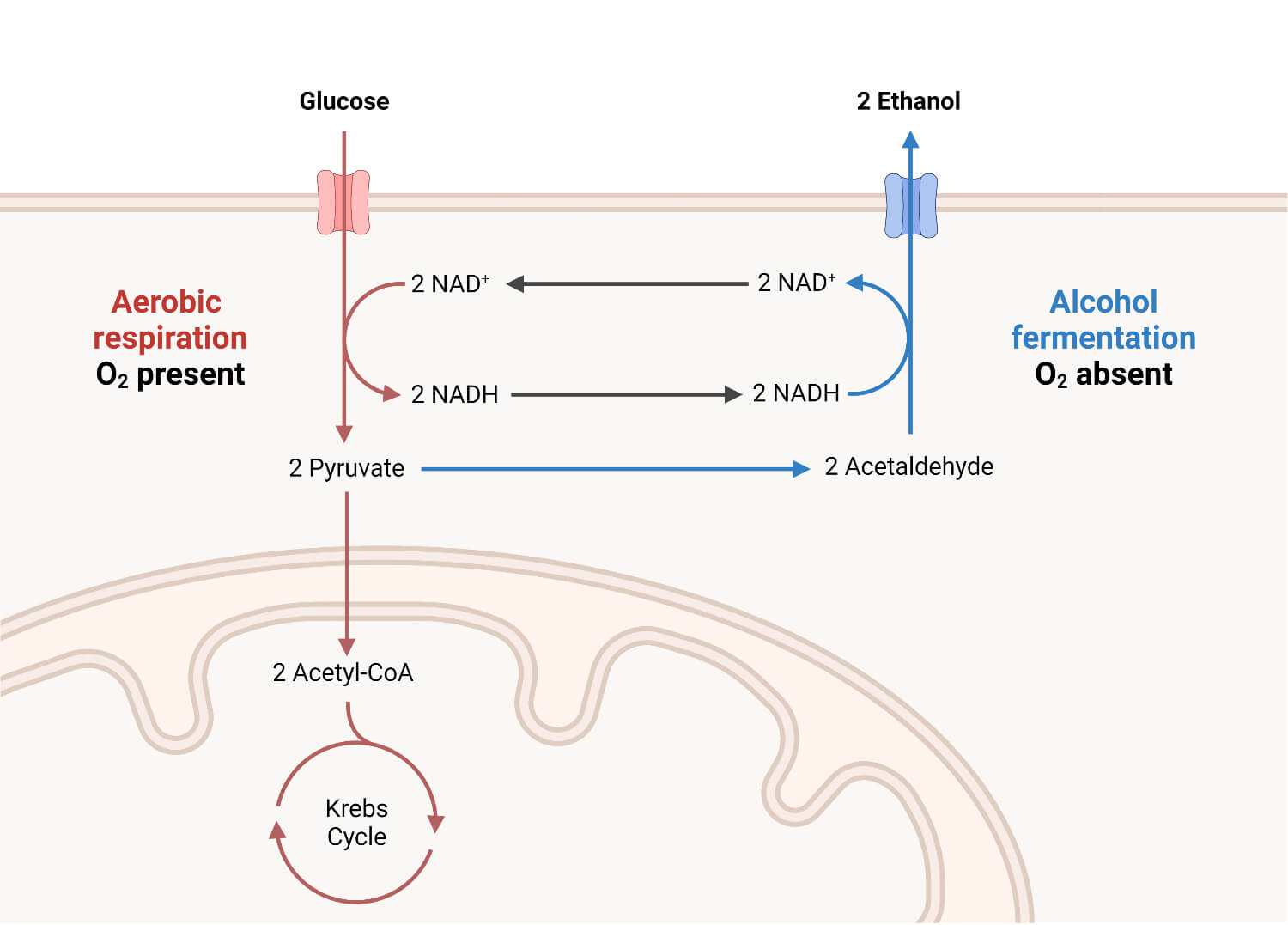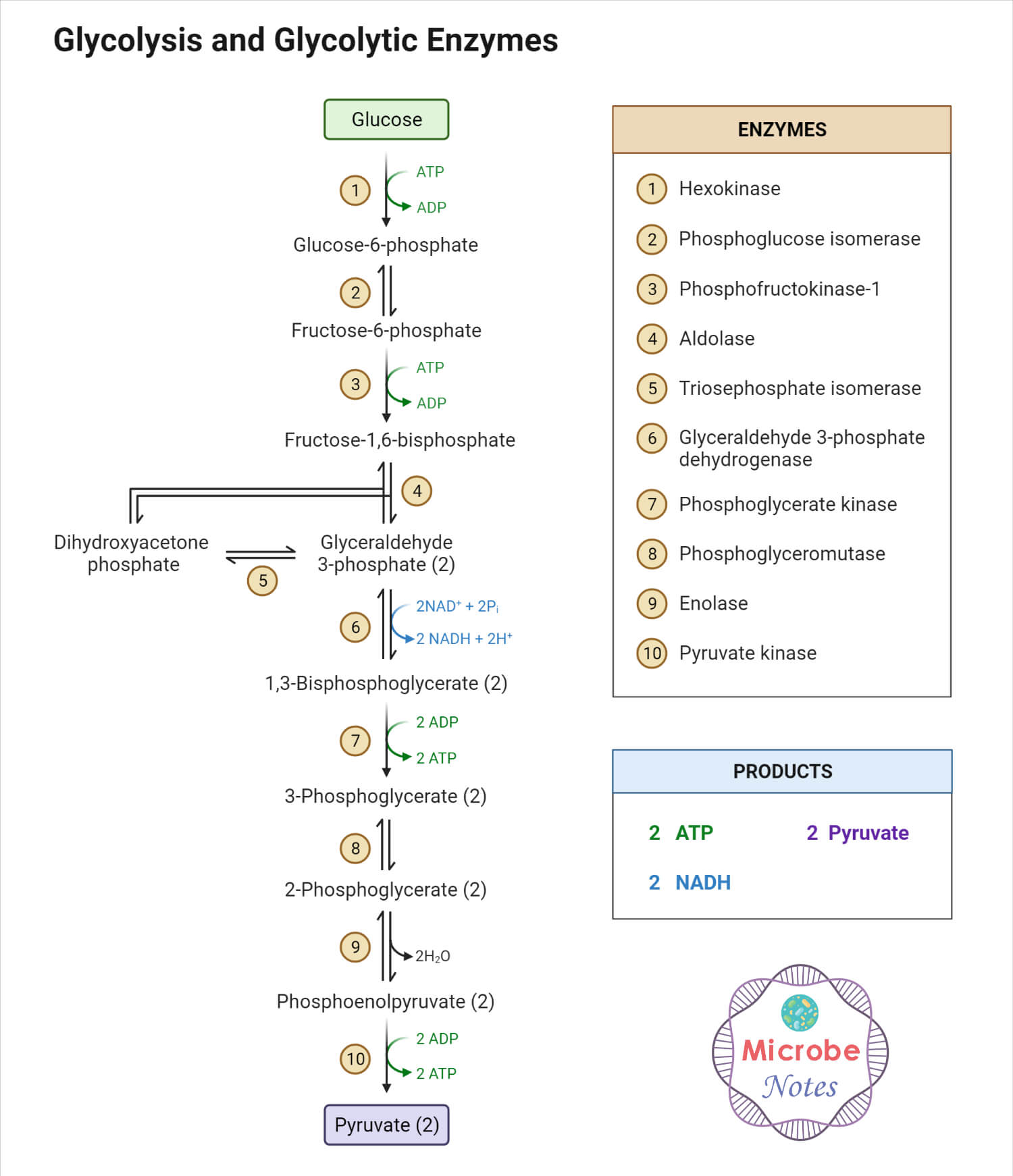Respiration is the metabolic process of breaking down the simple organic nutrients (food material) releasing the cellular energy in form of ATP (Adenosine Triphosphate) inside the living cell. It is a series of oxidation-reduction reactions where an electron is transformed from an electron donor to an acceptor. Ultimately, energy is released and conserved in the form of the ATP molecule. It is different from breathing which is the inhalation of atmospheric air (O2) and exhalation of CO2. It is often termed “cellular respiration”.
Based on the type of terminal electron acceptor in the respiration cycle, respiration can be classified as aerobic and anaerobic respiration. In aerobic respiration, oxygen (O2) is used as a terminal electron acceptor. In anaerobic respiration, molecules other than oxygen are used as terminal electron acceptors.
Interesting Science Videos
What is Anaerobic Respiration?
Simply, Anaerobic Respiration can be defined as the cellular respiration process occurring in an anoxic environment i.e. in the absence of oxygen. Anaerobic Respiration is the respiration process where the terminal electrons released during oxidation-reduction of nutrients are transferred to several organic and inorganic electron acceptors other than oxygen molecules to produce the energy molecule ATP. The usual terminal electron acceptors used in the anaerobic respiration process are sulfur (S), sulfate (SO4-2), ferric ion (Fe3+), nitrate (NO3–), DMSO, etc. Hence, it is the production process of ATP molecules in the absence of oxygen.
Unlike aerobic respiration which takes place in the cytoplasm and mitochondria, anaerobic respiration occurs only in the cytoplasm. It usually occurs in two stages; anaerobic glycolysis and fermentation. The end products are either organic acids (lactic acid) or ethanol and ATP molecules (energy). The overall reaction of anaerobic respiration of a glucose molecule can be expressed as follows;
Glucose + electron acceptors (other than O2) → Lactic acid / ethanol + 2 ATP molecules

It is shown by several anaerobic bacteria, yeasts, protozoans, helminths, and even animal cells. During severe muscle contraction and expansion, anaerobic respiration occurs in human muscle cells producing lactate. Besides, it also occurs in brain cells, retina, and RBCs.
The anaerobic respiration process results in the incomplete breakdown of the substrate (nutrients). Hence it is less efficient than aerobic respiration in terms of ATP generation. Only two molecules of ATP are generated in the process. However, it is a quicker process and produces essential intermediate products like ethanol and organic acids.
Types of Anaerobic Respiration
Based on the type of end product of respiration, anaerobic respiration can be classified into several types like; organic acid fermentation (lactic acid fermentation, butyric acid fermentation, propionic acid fermentation, mixed acid fermentation, etc.), methanogenesis, acetogenesis, denitrification, sulfur reduction, alcohol (ethanol) fermentation, butanediol fermentation, etc. The major types of anaerobic respiration are:
A. Lactic Acid Fermentation
It is a type of anaerobic respiration where sugar molecules (glucose and other six-carbon sugars) are metabolized to lactate, releasing the chemical energy in the form of ATP molecules. It is the fermentation process where pyruvate is produced at the end of glycolysis and is converted to lactate by the lactate dehydrogenase enzyme. It is also called ‘Lacto-fermentation’.

The general equation of lactic acid fermentation can be expressed as:
Glucose + ADP + NADH → Lactic acid + ATP + NAD+
It is one of the most common fermentation widely used in food preservation and fermented food production. Since ancient times, it has been in practice to ferment fruits, vegetables, cereals, milk (production of fermented dairy products), and meat and preserve them for later use.
It mainly occurs in the bacterial cytoplasm. Bacteria fermenting glucose to lactic acid are called “Lactic Acid Bacteria” (LAB), and they are widely used in the food industry and biotechnology. Common LAB are; Lactobacillus, Lactococcus, Leuconostoc, Streptococcus, Pediococcus, Enterococcus, etc.
Besides, it also occurs in the cytoplasm of higher animals, including humans. During strenuous muscular activities, lactic acid fermentation occurs in our body muscles due to the shortage of oxygen supply. This will result in muscle cramps or pain and fatigue sensation in our muscles after laborious muscular activities. Apart from muscles, this type of respiration is common in RBCs also as they lack mitochondria.
B. Ethanol Fermentation
It is another common type of anaerobic respiration process where the sugar molecules (glucose and other six-carbon sugars) are metabolized to ethanol, releasing the chemical energy in the form of ATP molecules. The pyruvate produced by the glycolytic cycle is converted to ethanol in the presence of the alcohol dehydrogenase enzyme. It is also called ‘alcoholic fermentation’.

The general equation of ethanol fermentation can be expressed as:
Glucose + ADP + NADH → Ethanol + ATP + NAD+
It is used universally for the production of alcoholic beverages. It is performed by yeasts like Saccharomyces cerevisiae, Schizosaccharomyces, Zygosaccharomyces, Candida, Pichia, etc. Besides, fungi like Aspergillus oryzae, bacteria like Zymomonas, etc., are also used. It also occurs in higher animals like Goldfish.
Steps of Anaerobic Respiration
Anaerobic respiration occurs in two steps; the first is glycolysis, and the second is fermentation.
A. Glycolysis
Glycolysis is defined as the sequence of catabolic reactions converting glucose (or glycogen) molecule to pyruvic acid using several enzymes inside the cytoplasm of every cell. In the process, a molecule of glucose is catalyzed to yield two molecules of pyruvic acids, two molecules of NADH, and two molecules of ATP. It occurs in the cytoplasm of every living cell in both aerobic and anaerobic respiration. It is also called “Embden -Meyerhof – Parnas (EMP) Pathway”.
It is a 10 step complex catabolic process where six-carbon sugar (glucose) is splitted into two 3 – carbon pyruvate molecules. The overall reaction is divided into three stages viz.;
1. Energy Investment Phase
It is the first phase where glucose is converted to Fructose – 1, 6 –bisphosphate using 2 molecules of ATP (hence called the energy investment phase) in a three-step reaction.
First, glucose is phosphorylated to glucose – 6 – phosphate (G-6-P) by the enzyme “hexokinase”. The G – 6 – P is reversibly isomerized to fructose – 6 – phosphate (F-6-P) in the next step by the enzyme “glucose – 6 – phosphate isomerase” in presence of Mg++ ion.
Finally, the F – 6 – P is phosphorylated to fructose – 1,6 – bisphosphate by the “phosphofructokinase” enzyme.

2. Splitting Phase
It is the second phase where the 6-carbon fructose – 1,6 – bisphosphate molecule is split into two 3 – carbon compounds glyceraldehyde – 3 – phosphate (G – 3 – P).
It is 2 step reaction where the fructose – 1,6 – bisphosphate is first enzymatically broken down to G – 3 – P and dihydroxyacetone phosphate by an enzyme called “aldolase (fructose bisphosphate aldolase)”. In the next step, dihydroxyacetone phosphate is reversibly isomerized to G – 3 – P by the enzyme “triosephosphate isomerase”.
3. Energy Generation Phase
It is the final phase of glycolysis where G – 3 – P is finally oxidized to pyruvate releasing two molecules of ATP.
In the first step, the G – 3 – P is oxidized to 1,3 – bisphosphoglycerate by the enzyme “glyceraldehyde – 3 – phosphate dehydrogenase” producing a molecule of NADH. The enzyme “phosphoglycerate kinase” reversibly catalyzes the conversion of 1,3 – bisphosphate to 3 – phosphoglycerate releasing an ATP molecule which will then be catalyzed to 2 – phosphoglycerate by another enzyme, “phosphoglycerate mutase”.
In a reversible reaction by “enolase” 2 – phosphoglycerate is dehydrated to phosphoenolpyruvate. Phosphoenolpyruvate will in turn, be dephosphorylated by “pyruvate kinase” producing a “pyruvate” and ATP molecule.
The overall chemical reaction can be summarized as following equation;
Glucose + 2 ATP + 2 ADP + 2Pi + 2 NAD+ → 2 Pyruvate + 2 NADH + 2 ATP
B. Fermentation
It is the process where pyruvate produced in glycolysis is reduced to an end product of anaerobic respiration (mainly ethanol or lactic acid). In the process, NADH is oxidized to NAD+, and the released proton is used to reduce the pyruvate in the presence of a different enzyme.
Fermentation may be homo-fermentation, i.e., producing only one type of product by reducing pyruvate, or maybe hetero-fermentation, i.e., producing two or more end products while reducing the pyruvate.
The end product of pyruvate reduction depends on the enzyme involved and the types of fermentation. In lactic acid fermentation, the end product is lactic acid, and in alcohol fermentation, the end product is ethanol.
1. Lactic Acid Fermentation
In this type, the pyruvate is reduced to L-lactate (the conjugate base of lactic acid). The reduction is catalyzed by the “lactate dehydrogenase” enzyme, and in the process, NADH is oxidized to NAD.
The equation of lactic acid fermentation is expressed as:

2. Ethanol Fermentation
In this type, the pyruvate is reduced to ethanol in a two-step reaction. At first, pyruvate is decarboxylated into acetaldehyde in the presence of TPP (Thymine pyrophosphate) by the enzyme “pyruvate decarboxylase”. A molecule of CO2 is released in this process. In the next step, acetaldehyde is reduced to ethanol by the enzyme “alcohol dehydrogenase”. A molecule of NADH is oxidized to NAD+ in this reaction.

Anaerobic Respiration Equation
Lactic Acid Fermentation
Step I: Glucose + 2 ATP + 2 ADP + 2 Pi + 2 NAD → 2 Pyruvate + 4 ATP + 2 NADH
Step II: 2 Pyruvate + 2 NADH → 2 Lactate (lactic acid) + 2 NAD
∴ Glucose + 2ADP + 2Pi → 2 Lactate + 2 ATP
Ethanol Fermentation
Step I: Glucose + 2 ATP + 2 ADP + 2 Pi + 2 NAD → 2 Pyruvate + 4 ATP + 2 NADH
Step II: 2 Pyruvate → 2 Acetaldehyde + 2 CO2
Step III: 2 Acetaldehyde + 2 NADH → 2 Ethanol + 2 NAD
∴ Glucose + 2 ADP + 2 Pi → 2 Ethanol + 2 ATP + 2 CO2 ↑
Products of Anaerobic Respiration
Based on the types of electron acceptors used in the respiration process, products of anaerobic respiration vary. Lactic acid, ethanol, CO2, and ATP are the common products of anaerobic respiration. Other compounds produced are acetic acid, butyric acid, methane, Fe(II), H2S, halide ions, succinate, NO2– and N2, U (IV), etc.
Application of Anaerobic Respiration
- It plays a critical role during biogeochemical cycles like Nitrogen Cycle, Iron Cycle, Sulfur Cycle, and Carbon Cycle. Several steps in these cycles require an anaerobic respiration process. For e.g., denitrification, sulfur reduction, methanogenesis, etc. are anaerobic respiration processes.
- It is used in sewage treatment plants and waste management systems. The denitrification step is used in the treatment of sewage to remove nitrate. Chlorinated chemicals, arsenic wastes, radioactive wastes, petroleum wastes, etc., are anaerobically reduced in bioremediation processes.
- Power generation through microbial fuel cells is an anaerobic respiration process.
- Production of organic acids like lactic acid, propionic acid, acetic acid, butyric acid, etc. for commercial and household uses.
- Alcohol fermentation is the most widely applied sector of anaerobic respiration. Production of alcoholic beverages (beer, wine, distilled alcohols, etc.) has a long history, and still, it covers a very large sector of business.
- Lactic acid fermentation, acetic acid fermentation, and other organic acid fermentation processes are used to produce fermented foods. Fermented dairy products, soya sauce, sourdough bread, Indian Idli and Dosa, fermented mustard green, pickled vegetables, sauerkraut, etc. are produced as a result of the organic acid fermentation process.
- Anaerobic lactic acid fermentation in our gut converts ammonia to ammonium ions. This prevents from harmful effects of ammonia in our body system.
Examples of Anaerobic Respiration
Alcoholic Beverage Production
The production of wine, beer, and other distilled ethanol products is the result of alcohol fermentation. Yeast like Saccharomyces cerevisiae, Schizosaccharomyces, Zygosaccharomyces, etc., are commonly used for ethanol production.
Biogas Production
The production of methane gas is an anaerobic fermentation process used for the digestion of organic waste. Methane gas is widely used as an alternative source of energy.
Production of Swiss Cheese
Swiss cheese has its distinct flavor and porous texture due to propionic acid fermentation. The acid gives the flavor, and the release of CO2 gas develops the characteristic holes in the cheese surface.
Vinegar Production
Vinegar used as a flavoring agent and food preservatives is a mixture of about 5 – 8% acetic acid. Its production is the double fermentation process. At first, alcohol fermentation produces ethanol. The ethanol is then oxidized by acetic acid bacteria (Acetobacter) to acetic acid.
Nitrate Reduction in Nitrogen Cycle
The reduction of nitrate (NO3 – ) to nitrite (NO2 – ) in the nitrogen cycle is an anaerobic respiration process called denitrification. Bacteria such as Pseudomonas, Clostridium, Geobacter, etc., perform denitrification.
References
- Lactic Acid Fermentation. (2020, August 13). University of Kentucky. https://chem.libretexts.org/@go/page/58862
- Electron Donors and Acceptors in Anaerobic Respiration. (2021, January 4). https://bio.libretexts.org/@go/page/8976
- National Research Council (US) Panel on the Applications of Biotechnology to Traditional Fermented Foods. Applications of Biotechnology to Fermented Foods: Report of an Ad Hoc Panel of the Board on Science and Technology for International Development. Washington (DC): National Academies Press (US); 1992. 5, Lactic Acid Fermentations. Available from: https://www.ncbi.nlm.nih.gov/books/NBK234703/
- Anaerobic Respiration: The Definitive Guide | Biology Dictionary
- 5 Examples of Anaerobic Respiration | Life Persona
- Anaerobic Respiration | Boundless Microbiology (lumenlearning.com)
- https://byjus.com/biology/aerobic-anaerobic-respiration/
- Anaerobic respiration | definition of anaerobic respiration by Medical dictionary (thefreedictionary.com)
- What is Anaerobic Respiration? – Biology Wise
- Anaerobic Respiration: Definition, Equation, and Examples (researchtweet.com)
- Anaerobic Respiration – Process – Regulation – TeachMePhysiology
- Anaerobic Respiration (With Diagram) (biologydiscussion.com)
- Anaerobic respiration: Definition, Overview & Equation (studysmarter.us)
- Glycolysis and Anaerobic Respiration – EONS LEARNING
- What Is Fermentation? – Definition, Types, Anaerobic Respiration (byjus.com)
